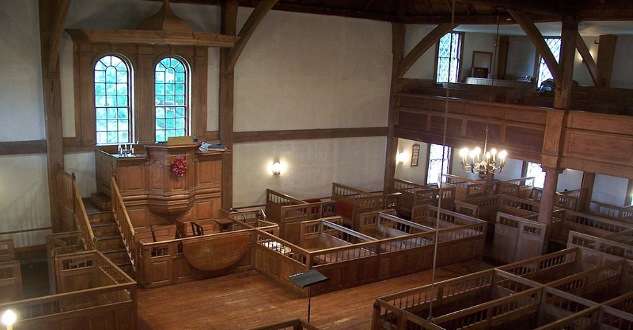Perhaps nothing revealed the puritanical contempt for comfort so much as the absence of a meetinghouse stove. The Puritans believed their religious zeal could warm them in unheated buildings, even in freezing New England winters.

The Old Ship Church in Hingham, Mass., didn’t have a stove until 1822. Photo courtesy Library of Congress.
And it did get cold. Samuel Sewall on Jan. 24, 1686, reported in his diary, “The communion bread was frozen pretty hard and rattled sadly into the plates.”
No matter how cold it got, no matter how much coughing in the meetinghouse, the Puritans brought babies were in on the Sunday after their birth to be baptized – with cold water.
Alice Morse Earle wrote in 1891 that people still alive remembered a universal and ‘noisy turning up of great-coat collars, the swinging of arms, and knocking together of the heavy-booted feet of the listeners towards the end of a long winter sermon.’
Some Puritan churches like the Old South Meeting House allowed foot stoves. But they recognized the danger of fire. In December 1771 the sexton of Old South had instructions to search the meetinghouse for any foot stoves left behind and to take them home. The owner then had to retrieve them and “make reasonable satisfaction” to the sexton for his trouble.
Other congregations were more puritanical – or at least more fearful of fire. The First Church of Roxbury banned foot stoves in its rebuilt meetinghouse after it burned down in 1747. Congregants warmed their feet instead with hot stones in baskets, or fur bags or even the family dog.
Enter the Meetinghouse Stove

The meetinghouse stove at the Society of Friends, Sabbathday Lake, Maine. Photo courtesy Library of Congress.
The Puritan congregations gradually relaxed and began to accept the meetinghouse stove. The comfort-loving libertines of Hadley, Mass., bought an iron stove for their meetinghouse in 1734.
Warmth did not come to the Puritan meetinghouse without controversy.
In 1819, the Puritans of Brimfield, Mass., finally acquiesced and decided to buy a meetinghouse stove, but one old parishioner refused to contribute. He said good preaching kept him hot enough without a stove. Members of the Old Ship Church in Hingham, Mass., held fast against warmth until 1822, nearly 150 years after the building went up in 1681.

Henry Ward Beecher
The Puritans of Litchfield, Conn., provided an entertaining drama over the introduction of the meetinghouse stove. The same thing may have happened in other towns. The Rev. Henry Ward Beecher told the story.
The meeting started on a warm Sunday after the installation of the meetinghouse stove, but no one lit a fire. A deacon’s wife, unalterably opposed to the stove, thought it was lit. The imaginary fire so overheated her she fainted and got carried out of the church. A man who favored the meetinghouse stove then approached it, warming his hands and making sure his coat didn’t get scorched.
Even the Puritans thought that was funny.
This story last updated in 2024.
Image: Interior of the Old Ship Church By Michael Carter – https://www.flickr.com/photos/michaelcarter/269096379/, CC BY-SA 2.0, https://commons.wikimedia.org/w/index.php?curid=6286653.

6 comments
[…] It took a century or so, but the Puritans finally introduced stoves into their meetinghouses — sometimes with results that made even a Puritan laugh. Click for more. […]
[…] to the meeting house in North Manchester, Maine, lies a cemetery surrounded by a wall with a strange rock in it. The […]
[…] High Tide Storm of 1723, the waters rose so high and so fast that worshipers were marooned in their meeting houses. In the Massachusetts towns of Marblehead and Salem, people climbed trees to avoid […]
[…] High Tide Storm of 1723, the waters rose so high and so fast that worshipers were marooned in their meeting houses. In the Massachusetts towns of Marblehead and Salem, people climbed trees to avoid […]
[…] By 1773, the population of the town reached 580 people — big enough and prosperous enough to build a meetinghouse. […]
[…] Hopestill earned enough money to send Wentworth to Governor Dummer Academy in Byfield, Mass. Wentworth took advantage of his unusual educational privilege and became a schoolmaster in Newmarket. By the time he reached 21 he owned more than 30 acres and a pew in the meetinghouse. […]
Comments are closed.